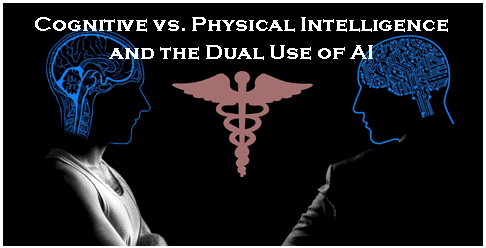
Cognitive vs. Physical Intelligence and the Dual Use of AI
In the summer of 1955 at Dartmouth University, four researchers developed a proposal for research on Artificial Intelligence or AI (McCArthy, Minskey, Rochester, & Shannon, 2006). Since this research was proposed, AI has played a key role across many industries. One of the most well-known AI platforms is the IBM supercomputer, Watson, which is marketed on their website as an “AI for smarter business” and lists a variety of industries. Just to name a few: risk and compliance, financial operations, IT operations, and health care. Watson once appeared on Jeopardy beating out Ken Jennings and Brad Rutter.
Cognitive vs. Physical Intelligence
While Artificial Intelligence can be fun and games, there are more serious applications to improve the lives and wellbeing of society. In a 2019 article in the Journal of Family Medicine and Primary Care, the contributors discuss two domains of intelligence – cognitive and physical. The authors state, “In the past, humans retained authoritative role over the machines due to cognitive advantage and machines conquered with humans mainly in raw physical capabilities” (Bhattacharya, et al., 2019).
Consider the use of a basic calculator. Humans decide what mathematical problem needs to be solved and will input that data into the calculator and within seconds an answer will populate. From there the human will decide the implication and use of that answer. As problems become more difficult, the computer must become more sophisticated and so does the software operating the computer. Even in the most basic linear algebraic equation (y=mx+b or ax+by=c) there are infinite number of solutions. Today we rely on computers to translate our voice and language into commands assisting us with our everyday lives. Smart homes equipped with Amazon’s Alexa or Apple’s Siri devices to turn on lights, play music, or operate televisions are done so by simple and natural voice commands.
In Japan an AI-based robot was introduced to assist with geriatric care reminding patients when it is time to take their medications among other day-to-day activities (Bhattacharya, et al., 2019). AI can also be used to help identify diseases and produce treatments. When developing treatments, there is a plethora amount of combinations to which AI becomes a handy tool in identifying beneficial treatments for various diseases such as cancer. A June 1st article in Forbes mentions a study that was published in the journal Nature that discusses dual use of AI. Researchers have discovered how AI can be perverted from a tool for discovering cures to a weapon for killing.
Dual Use of AI
Recall the cognitive and raw physical intelligence capabilities; in the Forbes article the contributor brings up a point to where a scientist or researcher with well intentions may want to partner with AI to help develop a cure for a horrific disease. “If I find something that cures a horrific disease and meanwhile it kills the person taking the cure, this doesn’t seem like a drug that we ought to be relying upon. In short, the aim is to find those molecular compounds that have the greatest promise while simultaneously proffering the least toxicity” (Eliot, 2022). In other words, AI must find the right combination to produce a treatment that will eliminate or treat the disease without killing the patient. For the AI device to be effective, it must be aware what is toxic or potentially lethal to humans. These researchers were concerned and curious with the potential abuse such AI information could produce. To test their curiosity they decided to switch the algorithm from producing the least toxic drug combination to the most toxic and lethal combination and their discovery was concerning. Within hours, the next morning, the researchers learned their MegaSyn AI system generated around 40,000 different molecules that is just as lethal as the nerve agent VX (Craig, 2022). According to the CDC, VX is a chemical warfare agent that is order less, tasteless, and when symptoms of exposure begin to occur, depending on the level of exposure, at that point it is too late and the target may not survive (Facts About VX, 2018).
This feature cannot simply be turned off. It is the ability of the MegaSyn AI to know how to produce toxic molecules in order to effectively prevent producing toxic molecules. As the perfect mastery of raw physical intelligence, the AI cannot distinguish if its product will be used for good or evil. All it is capable of doing is producing what it is programed to do with no cognitive reasoning as to its implications. The exact programing and algorithms were not published, nor was any of the 40,000 toxic molecules. The researchers only did a presentation on their finding on the dual use of AI; rather they just wanted to make the research community aware of good and dark side of dual use.
Works Cited
Bhattacharya, S., Pradhan, K. B., Bashar, M., Tripathi, S., Semwal, J., Marzo, R. R., . . . Singh, A. (2019). Artificial intelligence enabled healthcare: A hype, hope or harm. Journal of Family Medicine & Primary Care, 8(11):3461-3464.
Craig, J. (2022, May 17). Widely Available AI Could Have Deadly Consequences: US researchers’ “Dr. Evil project” proves drug discovery AI could be used to create biochemical weapons. Retrieved from Wired: https://www.wired.com/story/ai-dr-evil-drug-discovery/
Eliot, L. (2022, June 1). AI Ethics And Legal AI Experts Greatly Alarmed About Dual-Use AI Which Empowers So-Called Doctor Evil Projects, Including Possibly For AI Self-Driving Cars. Retrieved from Forbes: https://www.forbes.com/sites/lanceeliot/2022/06/01/ai-ethics-and-legal-ai-experts-greatly-alarmed-about-dual-use-ai-which-empowers-so-called-doctor-evil-projects-including-possibly-for-ai-self-driving-cars/?sh=3037ec8977ff
Facts About VX. (2018, April 4). Retrieved from Centers for Disease Control and Prevention: https://emergency.cdc.gov/agent/vx/basics/facts.asp#:~:text=VX%20is%20a%20human%2Dmade,of%20harmful%20effects%20they%20cause.
McCArthy, J., Minskey, M., Rochester, N., & Shannon, C. (2006). A Proposal for the Dartmouth Summer Research Project on Artificial Intelligence, August 31, 1955. AI Magazine, 27(4), 12.


